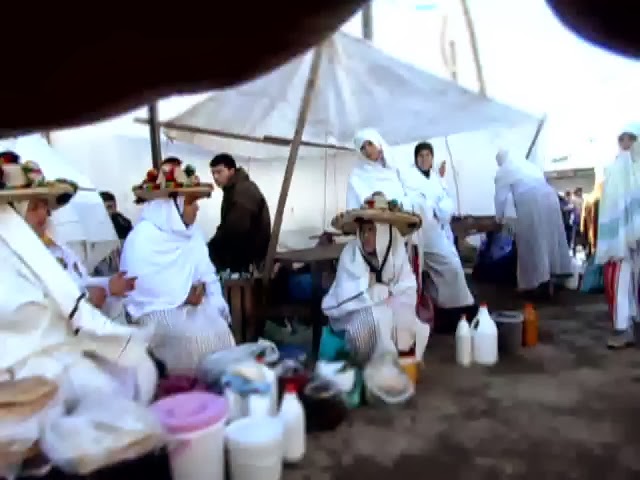 |
| The road to Bni Arouss with taxis crossing the condemned bridge |
The Thursday Bni Arouss market (Khmis Bni Arouss) is worth the trip up into the Rif Mountains. From Tangiers, you start off on the highway or the old main road and end up on small secondary roads, which have seen better days. Cars play a game of chicken as to which one will go off the paved road into the rough shoulder. Along the way, you pass modest homes, swank palaces and even a garage for “exotic cars.” With that description, the garage owner was advertising that he serviced and repaired Porsche, Ferraris and other luxury sports cars. Exotic cars on bad road? Palaces in remote villages? You may wonder at the contradictions which have only one explanation, the drug trade. The Rif has the mysterious quality of the Bekaa Valley in Lebanon.—all is not what it seems--green hills and fat livestock.
Let me make it quite clear, my husband and I were there to buy vegetables at the market, not the local weed at a Bni Arouss café. You also wonder how we came to know about Bni Arouss, a place Garmina the GPS, had trouble finding. Garmina kept showing our SUV traveling cross country instead of on a proper road. The answer to your question is that our housekeeper is from the Bni Arouss tribe and she wanted us to experience what she considered the best Thursday market. History buffs will recall that the Bni Arouss tribe protected Moulay Ahmed El Raisuni known as the “sultan of the Mountains.” Raisuni became a player in the 1904 presidential elections when he kidnapped Ion Perdicaris, an American citizen.
 |
| Bni Arouss ladies wearing their traditional clothes |
On the way, we stopped for coffee at a truck stop featuring fava bean soup (bessara) for breakfast and fish brought from nearly Larache for lunch. It took us two hours to reach Bni Arouss. We parked the car on the main street, hired a car watcher and headed into the market. This market had it all—vegetables, fruit, household goods, hand woven djellabahs (the all-purpose hooded robe), handmade agricultural implements, sidesaddles for donkeys and my favorite item, real handicrafts from the region. We soon filled our three large bags with fruit and vegetables. We hired a porter with a wheel barrow when our arms grew too tired. Having filled the wheel barrow up, we went back to the car and launched into our second round. Then, my husband bought three hand carved wooden serving spoons for $2 dollars and received instructions on how to soak them so they would not crack. I bought the local hand woven cloth that the Rif women wear tied around their waist as an apron for a $6 dollars each. I also wanted to buy a characteristic straw hat from the Rif (shishia) but the price in the market was too high. The local ladies were asking $25, whereas the Tangiers price was $5. If my husband had bought one without me, the price would have been better. Once a foreigner appeared with him, the price jumped.
 |
| The mother of our housekeeper |
When we returned to the car, our housekeeper’s mother was waiting for us with one other daughter. I complimented her on her shishia and she offered to give it to me. I insisted on paying for it and bought it at twice the going price. That was fine with me because the object was to give her some money in a way she would accept. She then said that she wanted to show us the local river and the broken bridge. So, she left her donkey in town and hopped into our car. She was a very agile woman, for someone who had raised eight children. She explained that the road stopped at the bridge and the only way to get to her village on the hill was to walk or ride a donkey. She pointed out her home, a whitewashed cottage with a red-tiled roof. I promised to visit her the next time we came to Bni Arouss. My husband prompted me to add “God willing” (Inch Allah.) Since I’m not sure that my donkey riding skills are up to the steep climb, I’ll walk there with her, Inch Allah.
Lisa, What an adventure! But for your housekeeper's mother, I suppose it is just everyday life. Thanks you for such a detailed story--I felt like I was there!
ReplyDeleteThe Indianapolis Motor Speedway is an automobile racing circuit located in Speedway, Indiana, in the United States. It is the home of the Indianapolis 500 and the Brickyard 400, and formerly the home of the United States Grand Prix.
ReplyDelete